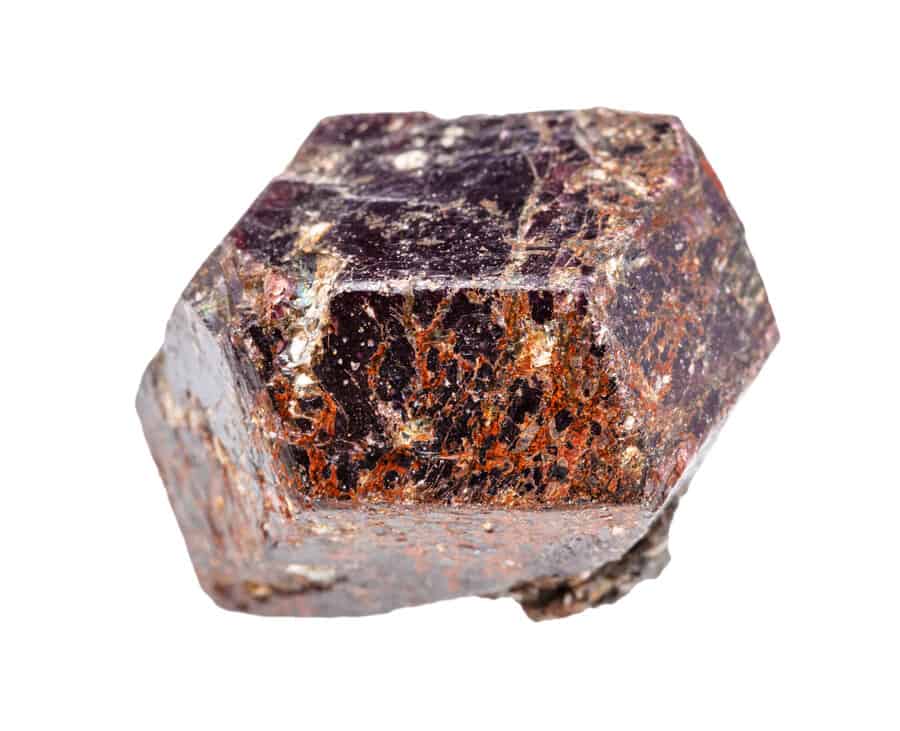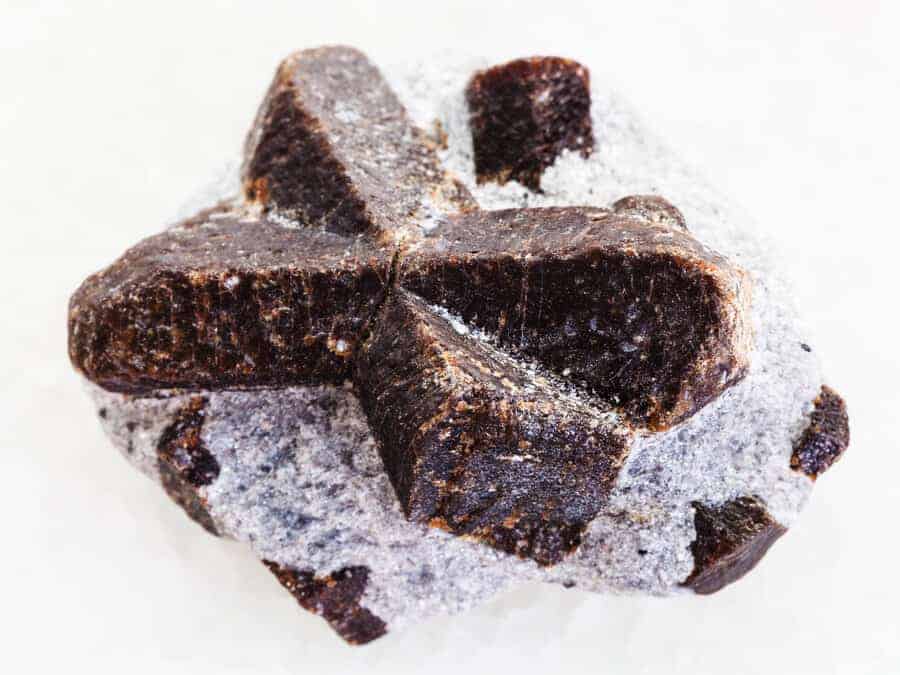For being a small state, Connecticut packs a lot of great rockhounding opportunities within its borders. Connecticut has a long history of gem production, and the many old mines and quarries which dot its landscape are a testament to that tradition. Connecticut is most well known for its garnets which are primarily sourced from the Triassic age schists exposed by the Connecticut River. While the overall variety of rocks, gems, and minerals is sub-par, the state does still offer quite a few great rockhounding locations.
The best places to rockhound in Connecticut are old mines and quarries, some of which can be hard to gain access to. Outcrops of schist and basalt in the Connecticut River Valley expose pegmatites, garnets, and other minerals. Ocean beaches and stream gravels also make for great rockhounding sites.
| State Symbols | |
|---|---|
| State Mineral | Almadine Garnet |
| State Rock | — |
| State Gemstone | — |
| State Fossil | Eubrontes Giganteus |

This article will dive deeper into the many great rockhounding sites across the state (along with maps), but I’d like to highlight a few standouts here. The best rockhounding sites for gems and minerals in Connecticut:
- Bantam Lake – The area around Bantam Lake is a great place to find quartz. Check out the south and southwest side for your best chances.
- Hammonasset Beach, Madison – Small grains of garnet can be found in the sand, especially near Webster Point on the western end of the beach. They are so prevalent they give the sand a pinkish color.
- Torrington – The basalt sills exposed all around Torrington are known to contain agates and prehnite. Search at the base of these exposures for material that has recently weathered out.
- Salmon River State Forest, Colchester – The best place to find garnets is near the SE corner of the Comstock Covered Bridge. You can also check the gravels all along the banks of the Salmon River.
- Farmington – You can try searching in almost any area surrounding Farmington for agates and prehnite. I would especially recommend searching in the gravels of stream beds.
- Tolland– Most of the road cuts and outcrops in this area expose garnet-bearing schists. Try looking in the talus and debris at their base for garnets, quartz crystals, and staurolites that have weathered out of the exposure.
- Quartzite Hill, Stafford – This is a relatively unique area because the garnets found here are in a quartzite matrix as opposed to schist.
- Plum Bank Beach, in gravels – The gravels along Plum Bank Beach will usually turn up some agates and moonstone.
- Long Hill Mine in Old Mine Park – This old mine is a well-known historical collecting site that has produced specimens of calcite, fluorite, pyrite, scheelite, and blue topaz.
Connecticut doesn’t have the largest array of rocks and minerals, but there are still quite a few worthwhile varieties that can be found across the state. The most notable mineral collected in Connecticut is probably almandine (an attractive species of garnet) which can be found in schists and gravels across a large area. The basalts exposed by the Connecticut River are also well known for prehnite.
The most commonly found and collected minerals in Connecticut are:
- Garnet
- Prehnite
- Staurolite
- Quartz
- Sphalerite
- Amethyst
- Soapstone
- Albite
- Aquamarine
- Tourmaline

If you’ve already found a rock and you’re not sure what it is, I would highly recommend checking out my Practical Rock Identification System. This bundle of information includes a book, videos, and online tools. It is, simply put, the most comprehensive and easy-to-understand rock identification system you’ll find anywhere.
You can also read through my free rock identification guide and mineral identification guide which are filled with useful information and tools.
Through quite a bit of research and cross-referencing of available literature, I have compiled this list of some prospective locations in Connecticut which I would recommend to people looking to do some rockhounding. These are mostly comprised of beaches, old mining prospects, washes, streams, and historically known rock and mineral collecting sites. For additional reading, I’d highly recommend these books you can find on Amazon:
Please remember that rock collecting locations are constantly changing. Specimens may become depleted from other collectors, the location may have been built on or altered, locality information in literature may be inaccurate, and property ownership may have changed hands. Joining up with a local rockhounding club for a group trip can often get you access to otherwise off-limits locations like privately owned mines and quarries. There are many rockhounding clubs in Connecticut but I’d specifically recommend the Meriden Mineral Club. Though there are many locations listed here, this list is far from exhaustive. A location’s listing here is not a guarantee of accuracy. Be safe, never go underground, and make sure to get permission from the landowner to search for and collect specimens.
If you’re planning on heading to the field, make sure you have all the gear you’ll need! To get started, you can check out my recommended gear page which contains my full reviews for every Geologist’s favorite rock hammer and the best hiking backpack I’ve ever owned.
Rockhounding Sites in Connecticut
Important Disclaimer: I have not been to these locations myself, and I do not know if they are currently open for collecting. Use this resource as a guide to get you started. Follow posted signage and always get permission from the landowner to collect.
NOTE: All the locations listed in these tables are clickable, and will take you to the location on Google Maps.
Litchfield County
Litchfield County contains many great rockhounding sites including old mines, quarries, and outcrops. You can hope to find specimens of agate, prehnite, quartz, pyrite, staurolite, garnet, and many other minerals. For an easy and fun day of rockhounding I’d recommend checking out the south side of Bantam Lake for rose quartz or any basalt exposures you can find around Torrington for agate and prehnite.
| Location | Rocks & Minerals |
|---|---|
| Barkhamsted, area outcrops | Actinolite, Asbestos, Soapstone |
| Cornwall, W side pegmatite outcrops | Graphite |
| Litchfield, area exposures of mica schist | Corundum, Pyrite, Staurolite, Talc |
| Bantam Lake, S side | Quartz (rose quartz) |
| Roebling Mine, New Milford | Aquamarine, Beryl, Biotite, Feldspar, Garnet, Quartz (smokey), Muscovite, Tourmaline |
| Old Iron Mine at Mine Hill | Chalcopyrite, Galena, Pyrite, Quartz crystals, Siderite, Sphalerite |
| Torrington, area basalt sills | Agate, Prehnite |
Hartford County
The many area mines and quarries in Hartford County are known to have produced a wide variety of rocks and minerals, but gaining permission to collect may be a struggle. I would recommend checking out the many gravels and stream beds in the Farmington area for nice agates and prehnite.
| Location | Rocks & Minerals |
|---|---|
| Bristol Copper Mine | Bornite, Chalcocite crystals, Calcite, Chalcopyrite, Chrysocolla, Malachite |
| Canton, quartz vein exposure in local stream | Amethyst |
| East Gransby Quarry | Datolite (gem-quality). Aragonite, Calcite, Celestine, Epidote, Fluorite, Galena, Prehnite, Quartz, etc. |
| Farmington, area gravels and surfaces | Agate, Prehnite |
| Glastonbury, area quarries | Columbite, Feldspar |
| Old Simpson Quarry, Glastonbury | Aquamarine, Quartz (smoky) |
| Quarries near Hale’s Brook | Beryl, pegmatite minerals |
| Simsbury Mine | Chalcocite, Cuprite, Malachite, Copper, etc. |
| Meriden, area quarries | Quartz, Amethyst, Calcite, Gypsum |
Tolland County
Road cuts and other outcrops in Tolland County make for great rockhounding locations because the schists the expose are laden with fun and interesting minerals like quartz, staurolite, and especially garnet. Try looking at the base of these exposures for any material which has been freshly weathered away, both to save you some energy from hammering and to preserve the outcrop.
| Location | Rocks & Minerals |
|---|---|
| Union, a road cut S of Bigelow Pond | Feldspar, Moonstone, Cordierite |
| Rockville, area quarries | Whetstone |
| Stafford, area mines and quarries | Bog Iron Ore, Limonite, Quartz crystals, Staurolite |
| Tolland, area schist exposures | Quartz crystals (rose quartz), Staurolite, Garnet |
| Vernon, area schist exposures | Quartz crystals (rose quartz), Staurolite, Garnet |
Fairfield County
Almost any rocky exposure or outcrop in this area of Connecticut will offer a good opportunity to do some rockhounding, especially if you can locate and follow a pegmatite vein. The soapstone found around Greenwich is particularly appealing because it happens to be great for carving.
| Location | Rocks & Minerals |
|---|---|
| Bridgewater, area mines and deposits | Calamine, Galena, Cerussite, Pyromorphite, Sphalerite |
| Danbury, many area pegmatite outcrops | Graphite |
| Greenwich, area pegmatite outcrops | Soapstone |
| Lane’s Mine in Monroe | Arsenopyrite, Bismuth, Pyrite, Sphalerite, Wolframite |
| Redding, area pegmatite outcrops | Graphite |
| Aldrich Park, a rocky exposure | Quartz |
| Long Hill Mine in Old Mine Park | Calcite, Fluorite, Pyrite (cubes), Scheelite, Topaz crystals (blue) |
| Wilton, an old lead mine | Arsenopyrite, Bismuth, Galena, Pyrite, Wolframite, Quartz |
New Haven County
This area of the state is particularly appealing to me because of the reported finding of agates, especially around Guilford and East Haven. There are also several quarries where you can find, among other things, amethyst crystals. As always, be sure to gain permission to search and collect at each location you wish to visit.
| Location | Rocks & Minerals |
|---|---|
| Bethany, outcrops to N | Graphite |
| Cinque Quarry, East Haven | Amethyst, Smoky Quartz |
| Guilford & East Haven, area | Agate |
| Mt. Carmel, area mines | Bornite, Chalcocite |
| Hubbard Park, surrounding reservoirs | Quartz |
| Pine Rock Quarry | Prehnite, Calcite, Serpentine |
| Lamberts Mine | Chalcopyrite |
| New Haven Traprock Quarry | Amethyst |
Middlesex County
There are far too many old mines and quarries in the county list individually, but if you can gain access almost any of them will present a great opportunity to find a wide variety of minerals. The fee-to-dig mine at Gillette Quarry offers an especially appealing list of rocks and minerals. I would also recommend checking out the western side of Collins Hill for fun minerals like citrine, tourmaline, and apatite.
| Location | Rocks & Minerals |
|---|---|
| Slocum Prospect, East Hampton | Beryl, Quartz (rose quartz) |
| Gillette Quarry, Haddam (fee) | Amazonite, Aquamarine, Beryl, Chrysoberyl, Garnet, Quartz crystals, Tourmaline |
| Middletown, area quarries and mines | Galena, Chalcopyrite, Sphalerite |
| Riverside Quarry | Aquamarine, Beryl |
| White Rocks Quarry | Beryl, Tourmaline |
| Pelton’s Quarry | Citrine, Quartz (rose, smoky, clear) |
| Collins Hill, W side near peak | Apatite, Aquamarine, Beryl, Citrine, Bismuthinite, Columbite, Feldspar, Quartz (rose, smoky, clear), Spodumene, Tourmaline |
| Walden Gem Quarry | Albite, Aquamarine, Beryl, Pollucite, Garnet, Lepidolite, Spodumene, etc. |
New London County
| Location | Rocks & Minerals |
|---|---|
| New London, quarries all over the county | Apatite, Spodumene |
| Norwich, area outcrops | Corundum, Sillimanite |
| Plum Bank Beach, in gravels | Agate, Moonstone |
Where to Find Garnet in Connecticut
Garnet is the state gemstone of Connecticut, and for good reason. Several varieties of garnet can be found in localities all across the state and any collector in the area will want to be sure to snag some for themselves. As relatively common as it is, you still need to know where to look in order to increase your chances of finding a quality specimen. This list is far from exhaustive (there are countless mines and quarries in Connecticut where garnet and other minerals can be found) but it should give you a good starting point if you want to go look for garnet. I would definitely recommend checking out the Connecticut Geological Survey’s “Garnet Trail”, whose locations I have included in the list below, though not all locations may allow collecting.
The best places to find garnet in Connecticut are:
- Eisenhower Park, Milford – Look for outcrops of the Wepawaug Schist in the western part of the park. These schists contain small garnets about a half-centimeter in size.
- Hammonasset Beach, Madison – Small grains of garnet can be found in the sand, especially near Webster Point on the western end of the beach. They are so prevalent they give the sand a pinkish color.
- Rocky Glen State Park – Accessed via a hiking trail which begins to the south, outcrops of schist in this area contain many small garnets.
- Salmon River State Forest, Colchester – The best place to find garnets is near the SE corner of the Comstock Covered Bridge. You can also check the gravels all along the banks of the Salmon River.
- Kongscut Land Trust, Glastonbury – This area is full of hiking trails that pass by garnet-bearing schists and soils.
- Bolton Notch State Park – A short way from the Mohegan Trail parking lot, head north and locate an exposure of the Littleton Schist.
- Gerber Lane Road Cut, Tolland – Most of the road cuts in this area expose garnet-bearing schists. Try looking in the talus and debris at their base for garnets that have weathered out of the exposure.
- Quartzite Hill, Stafford – This is a relatively unique area because the garnets found here are in a quartzite matrix as opposed to schist.
Tip: Check out my Complete Rock Tumbling Guide to make your rocks and gemstones really shine!
Connecticut Rockhounding Laws & Regulations
One of the most common questions rockhounds have is whether or not they are allowed to collect at a certain location. It is the responsibility of each rockhound to obtain permission from a landowner to search and/or collect on a piece of property.
The ownership and status of land can and does change frequently, making it impossible to document accurate information on this page. However, I have compiled a list of resources here so that you may investigate and obtain permission for any locations (found here or elsewhere) for yourself.
Public Land Resources
I have written entire articles which cover the rockhounding laws and regulations for nearly every type of public land you can think of. I encourage you to check them out if you are curious about the legalities of rock and mineral collecting.
- Rockhounding on Public Land: Laws and Regulations
- Can You Collect Rocks in State Parks? All 50 States Answered
To determine what type of public land a particular location is on, I would recommend starting with the Connecticut Department of Energy and Environmental Protection’s Recreational Maps.
Private Land Resources
As with most states, each county in Connecticut will have records of who owns each piece of property. Unfortunately for rockhounds, the law in most states prohibits them from publishing their names or contact information online. You can usually get the landowner’s name and address by visiting the county records office. In Connecticut, I would recommend starting with the County Assessor’s office.
Sources & Further Reading
The locations and information contained in this article are primarily derived from academic papers, online resources, and other outside sources. If you would like to read some of the source material for yourself I have listed them below. The majority of these locations are my interpretation of Robert Beste’s A Location Guide for Rock Hounds in the United States. Other sources include:
